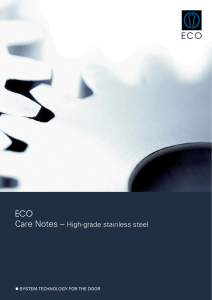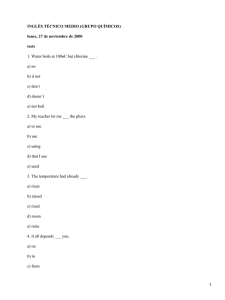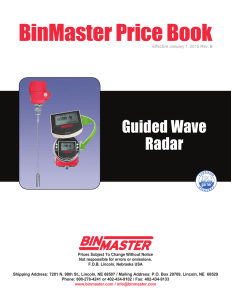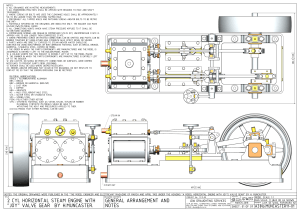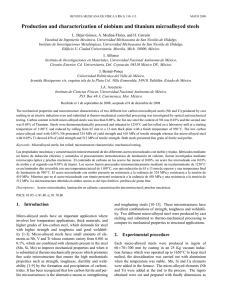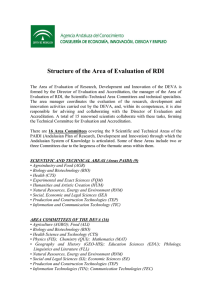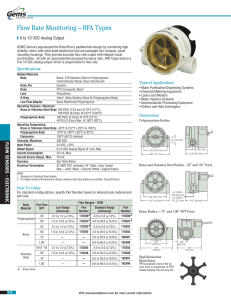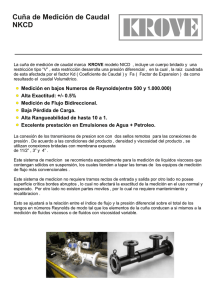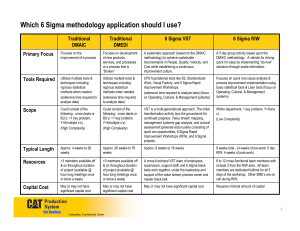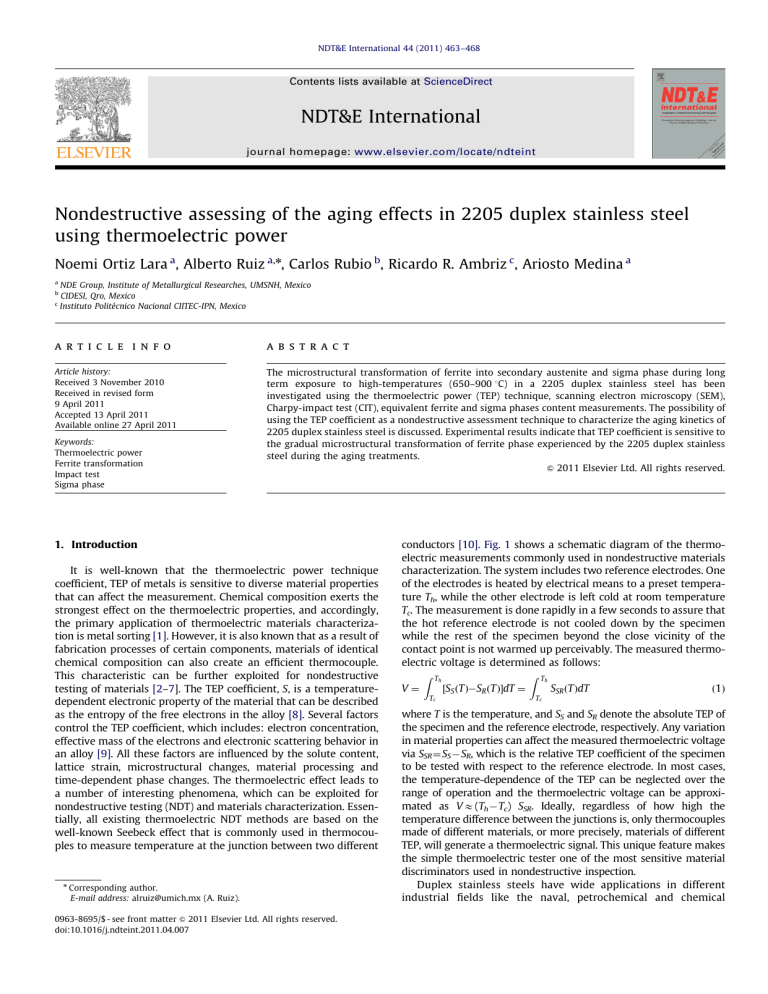
NDT&E International 44 (2011) 463–468 Contents lists available at ScienceDirect NDT&E International journal homepage: www.elsevier.com/locate/ndteint Nondestructive assessing of the aging effects in 2205 duplex stainless steel using thermoelectric power Noemi Ortiz Lara a, Alberto Ruiz a,n, Carlos Rubio b, Ricardo R. Ambriz c, Ariosto Medina a a NDE Group, Institute of Metallurgical Researches, UMSNH, Mexico CIDESI, Qro, Mexico c Instituto Politécnico Nacional CIITEC-IPN, Mexico b a r t i c l e i n f o abstract Article history: Received 3 November 2010 Received in revised form 9 April 2011 Accepted 13 April 2011 Available online 27 April 2011 The microstructural transformation of ferrite into secondary austenite and sigma phase during long term exposure to high-temperatures (650–900 1C) in a 2205 duplex stainless steel has been investigated using the thermoelectric power (TEP) technique, scanning electron microscopy (SEM), Charpy-impact test (CIT), equivalent ferrite and sigma phases content measurements. The possibility of using the TEP coefficient as a nondestructive assessment technique to characterize the aging kinetics of 2205 duplex stainless steel is discussed. Experimental results indicate that TEP coefficient is sensitive to the gradual microstructural transformation of ferrite phase experienced by the 2205 duplex stainless steel during the aging treatments. & 2011 Elsevier Ltd. All rights reserved. Keywords: Thermoelectric power Ferrite transformation Impact test Sigma phase 1. Introduction It is well-known that the thermoelectric power technique coefficient, TEP of metals is sensitive to diverse material properties that can affect the measurement. Chemical composition exerts the strongest effect on the thermoelectric properties, and accordingly, the primary application of thermoelectric materials characterization is metal sorting [1]. However, it is also known that as a result of fabrication processes of certain components, materials of identical chemical composition can also create an efficient thermocouple. This characteristic can be further exploited for nondestructive testing of materials [2–7]. The TEP coefficient, S, is a temperaturedependent electronic property of the material that can be described as the entropy of the free electrons in the alloy [8]. Several factors control the TEP coefficient, which includes: electron concentration, effective mass of the electrons and electronic scattering behavior in an alloy [9]. All these factors are influenced by the solute content, lattice strain, microstructural changes, material processing and time-dependent phase changes. The thermoelectric effect leads to a number of interesting phenomena, which can be exploited for nondestructive testing (NDT) and materials characterization. Essentially, all existing thermoelectric NDT methods are based on the well-known Seebeck effect that is commonly used in thermocouples to measure temperature at the junction between two different n Corresponding author. E-mail address: [email protected] (A. Ruiz). 0963-8695/$ - see front matter & 2011 Elsevier Ltd. All rights reserved. doi:10.1016/j.ndteint.2011.04.007 conductors [10]. Fig. 1 shows a schematic diagram of the thermoelectric measurements commonly used in nondestructive materials characterization. The system includes two reference electrodes. One of the electrodes is heated by electrical means to a preset temperature Th, while the other electrode is left cold at room temperature Tc. The measurement is done rapidly in a few seconds to assure that the hot reference electrode is not cooled down by the specimen while the rest of the specimen beyond the close vicinity of the contact point is not warmed up perceivably. The measured thermoelectric voltage is determined as follows: Z Th Z Th V¼ ½SS ðTÞSR ðTÞdT ¼ SSR ðTÞdT ð1Þ Tc Tc where T is the temperature, and SS and SR denote the absolute TEP of the specimen and the reference electrode, respectively. Any variation in material properties can affect the measured thermoelectric voltage via SSR ¼SS SR, which is the relative TEP coefficient of the specimen to be tested with respect to the reference electrode. In most cases, the temperature-dependence of the TEP can be neglected over the range of operation and the thermoelectric voltage can be approximated as VE(Th Tc) SSR. Ideally, regardless of how high the temperature difference between the junctions is, only thermocouples made of different materials, or more precisely, materials of different TEP, will generate a thermoelectric signal. This unique feature makes the simple thermoelectric tester one of the most sensitive material discriminators used in nondestructive inspection. Duplex stainless steels have wide applications in different industrial fields like the naval, petrochemical and chemical 464 N. Ortiz Lara et al. / NDT&E International 44 (2011) 463–468 V + − reference electrodes cold tip hot tip specimen Fig. 1. Schematic diagram of the dual-tipped probe thermoelectric measurements most often used in nondestructive materials characterization. industries. A wide range of applications of these steels are related to their high strength and excellent toughness properties as well as their high corrosion resistance [11]. The excellent mechanical properties exhibited by these steels are due to a duplex microstructure that consists of approximately the same amounts of austenite (g) and ferrite (d). To some degree, austenite ensures the toughness of the material and d-ferrite is responsible for the strength [12]. However, during some fabrication processes such as welding, the steel is subjected to elevated temperatures raising the susceptibility of this steel to the precipitation of second phases. Of main concern is the precipitation of s-phase during exposure to elevated temperatures in the range 600–900 1C [13]. Sigma phase is a hard and brittle intermetallic phase. Studies of the microstructural evolution in 2205 duplex stainless steel aged at high temperatures show that s-phase precipitates in the interface g/d at short aging times through a heterogeneous nucleation and growth process [14–18]. It has been observed that the fast formation kinetics of s-phase dramatically decreases impact properties and corrosion resistance [19,20]. Several researchers have investigated the phenomenon of ferrite decomposition and sigma phase precipitation [21–24] therefore the ferrite transformation phenomenon is well understood. Few investigations have been conducted to nondestructively characterize the thermal effect on duplex stainless steels. Kawaguchi and Yamanaka [7] investigated the thermal effect in a cast duplex stainless steel at a temperature of 400 1C. They found that the TEP signals of cast duplex stainless steel increases with the distribution of the Cr concentration. Ruiz et al. [25] investigated the thermal effect on duplex stainless steel using ultrasonic attenuation and shear wave velocity measurements. Their results indicate that the attenuation measurements can predict an early thermal degradation. Elmer et al. [26] studied the microstructural transformation of ferrite, austenite and sigma phase of 2205 DSS using synchrotron radiation. Based on the amounts of sigma, ferrite and austenite measured at 850 1C, they concluded that the dissolution temperature is under predicted by the thermodynamic calculations. In an effort to find a rapid and reliable alternative NDE technique, this investigation undertakes an interdisciplinary research to study TEP measurement capabilities to assess material microstructure, processing and mechanical characteristics of 2205 duplex stainless steels. 2. Experimental 2.1. Material preparation and methods Type 2205 duplex stainless steel plate with 12.7 mm thickness was used in this study. The experimental work consisted of TEP, CIT, SEM, ferrite and sigma phase content measurements. The TEP coefficient was used as the electronic measurement to assess the microstructural changes endured by the 2205 duplex during thermal aging. TEP measurements were performed on four sets of specimens, each specimen measuring 25 20 12.7 mm3. A series of aging treatments were performed at 900, 800, 700 and 650 1C for different holding times ranging from 1 min to 240 h depending on the holding temperature. These treatments were interrupted by water quenching for each sample. The thermoelectric voltage was measured with a Walker Scientific alloy thermo-sorter model ATS-6044T using a probe with cold and hot tips of copper and gold, respectively. The TEP of each sample was calculated using a lineal model obtained from best-fitting the measured thermoelectric voltages in materials with known TEP namely copper, alumel and chromel. In order to determine the effect of temperature and aging time on impact properties a series of Charpy-impact bar specimens of square cross section (10 mm 10 mm) with 451 V-notch were fabricated and heat-treated at 900, 700 and 650 1C for different aging times. For microstructural analysis, samples were prepared by metallographic electro-polishing and etching in a KOH electrolyte (10 g KOH, 100 ml water) with a voltage of 3 V for approximately 10 s. Microstructural examination of the samples was done using a JEOL JSM-5910LV scanning electron microscope. The equivalent ferrite content was measured in each sample after each treatment using a MP30E FERITSCOPEs. Finally, sigma phase content was measured using commercial software and compared to an existing sigma phase predicting model. 3. Results and discussion 3.1. Effect of the aging treatment on the microstructural evolution In the temperature range between 650 and 900 1C, duplex stainless steel experiences a phase transformation through the reaction d-g2 þ s, which reduces the ferrite content and significantly affects the impact properties of the 2205 duplex stainless steel. As it can be observed in the scanning electron microscopy micrographs of Fig. 2, the sample aged at 650 1C the microstructure does not show noticeable changes for times lower than 30 min and the duplex phase characteristic of this steel is maintained with large and elongated island-like austenitic grains (bright) in a more or less continuous matrix of ferrite (dark) as shown in Fig. 2(a). For the sample aged for 1 min at 900 1C Fig. 2(b), the ferrite phase experiences noticeable changes, due to the formation of small ferrite grains with cellular shape, which breaks down the elongated morphology of the ferrite grain. As an example of the effect of aging time in the ferrite transformation, Fig. 3(a–f) shows a sequence of SEM micrographs of the microstructural changes that take place in the 2205 duplex stainless steel aged at 700 1C for times up to 240 h. As depicted in Fig. 3(a), the microstructure shows no appreciable change in percentage of ferrite. However, as in the case of the sample treated at 900 1C, there is a gradual formation of new grain boundaries in the initially elongated ferrite matrix to form again small ferrite grains with cellular shape. Also, as in the case of Fig. 2(b), the g/d interface is more defined showing bright areas that indicate the beginning of the precipitation of second phases. This condition leads to a loss of chromium in the neighboring ferrite region, and therefore a migration of the initial g/d grain boundary into the ferrite grain. It has been reported that in an early stage of the ferrite transformation, the higher diffusivity of carbon atoms produces the precipitation of chromium carbides at the g/d interfaces where Cr-rich ferrite intersects with C-rich austenite [20,21]. In Fig. 3(c), it is observed that at 1 h holding N. Ortiz Lara et al. / NDT&E International 44 (2011) 463–468 465 Fig. 2. Microstructure of the 2205 duplex stainless steel: (a) aged for 30 min at 650 1C and (b) aged for 1 min at 900 1C. Fig. 3. Scanning electron microscopy sequence of the microstructural changes of 2205 duplex stainless steel aged at 700 1C. (a–b) formation of new grain borders in the ferrite, (c) sigma phase precipitation at the grain boundaries and (d–f) diminishing of equivalent ferrite and growth of sigma phase and austenite. time, the formation of new grains of ferrite with cell-like form is completed and a new defined border in the ferrite phase gives rise to the formation of secondary austenite (g2), which has different chemical composition than the original austenite phase [16]. Sigma phase begins to precipitate slightly after the precipitation of chromium carbides and as it is observed in Fig. 3(c) sigma phase preferentially nucleates at the g/d interface where depending on the aging temperature and time it will continuously grow. This is clearly seen in Fig. 3(d–f), where a significant and progressive diminishing of ferrite phase occurs followed by a continuous growth of secondary austenite and a coarsening of particles of sigma phase. The microstructural analysis of Figs. 2 and 3 indicates that it is clear that temperature plays an important role in the rate of ferrite transformation that affect the impact properties of this steel. From the literature, it is not possible to establish a universal master model that can predict N. Ortiz Lara et al. / NDT&E International 44 (2011) 463–468 the kinetics of ferrite decomposition since numerous physical and metallurgical parameters could affect the transformation kinetics and the modes of ferrite transformation. These parameters include variations in the chemical composition, ferrite grain size and volume fraction as well as temperature of solution treatment and conformation treatment, the effect of aging time and holding temperature. Among the models to predict the fraction of sigma phase, one of the most used theories is the Johnson–Mehl–Avrami (JMA) model. 3.2. TEP measurements Fig. 4 shows the experimentally determined TEP coefficient of the 2205 duplex stainless specimens aged at the different holding times. For the case of samples aged at 900 1C, the TEP presents a lower value in comparison to the other holding temperatures. Also, there is a maximum value of the TEP coefficient after 5 min holding and thereafter the TEP shows a monotonic decrease as aging time increases. The TEP coefficient measured in samples aged at 800 1C temperature presents a maximum value at 5 min and then slowly changes for the next 25 min and starts to decrease rapidly after that. A quite different behavior was exhibited by the samples aged at 700 and 650 1C. In both cases and at low holding times, the measured TEP shows a small but continuous decrement up to 30 min and 2 h for the 700 and 650 1C cases, respectively. After that, the TEP begins to increase and reach maximum value of 1.16 mV/1C after 1 and 6 h for the 700 and 650 1C treatments, respectively. As shown in Fig. 3(c) the maximum values in the TEP have been related to the formation of a more defined border in the ferrite grains and has been related to carbide precipitation [27]. Following these maximum values, the TEP begins to decrease monotonically and presents a sharp drop. Finally, for longer holding times at 900 and 800 1C, the TEP stabilizes after the 10 h treatment to reach values of approximately 1.5 and 1.68 mV/1C, respectively. 3.3. Equivalent ferrite and sigma phase content measurements Fig. 5 shows the measured equivalent ferrite as a function of aging time in four sets of samples. The results indicate that the loss of equivalent ferrite content is highly influenced by the amount of thermal exposure. The initial equivalent ferrite content of the samples aged at 900 1C is approximately 25 pct lower than that exhibited at lower holding temperatures. At this temperature and time up to 5 min, equivalent ferrite content remains constant and decreases rapidly after 10 min of exposure to reach a minimum value of approximately 3.8 pct at 30 h. At a temperature of 800 1C, equivalent ferrite content remains constant for low holding times and shows a more rapid reduction after 10 min to reach a minimum value of 1.9 pct at 20 h. At 700 1C, content of equivalent ferrite remains constant up to 1 h. After that, its content continuously decreases up to 12 h holding time and then sharply decreases for higher holding times. After 48 h, the rate of equivalent ferrite reduction slows down reaching about 6.9 pct at 240 h. Finally at 650 1C, the equivalent ferrite content stays constant for up to 2 h to sharply decrease after 2 h holding time to reach a value of 13.1 at 240 h. From Figs. 4 and 5, it is clear that for some temperatures, TEP coefficient and equivalent ferrite content exhibit similar trends. Aiming to establish a relationship between equivalent ferrite content and TEP coefficient, a graph correlating the TEP coefficient and the normalized fraction of equivalent ferrite is shown in Fig. 6. It is evident that a somewhat linear correlation exists between the two quantities in the equivalent ferrite fraction range of 0.2–0.72. The equivalent ferrite fraction here is obtained by normalizing the measured equivalent ferrite content values to 50 Equivalent ferrite content [%] 466 40 800 °C 900 °C 35 30 25 20 15 10 0 0.01 1 10 Aging time [h] 0.1 100 1000 Fig. 5. Change on the equivalent ferrite content as function of aging time in aged 2205 duplex stainless steel. 2 900 °C 800 °C 700 °C 900 °C 650 °C 800 °C 700 °C 650 °C 1.5 Thermoelectric power [µV /°C] 1.5 Thermoelectric power [µV /°C] 650 °C 700 °C 5 2 1 0.5 0 -0.5 -1 1 0.5 0 -0.5 -1 -1.5 -1.5 -2 0.01 45 -2 0.1 1 10 Aging time [h] 100 1000 Fig. 4. Measured TEP coefficient as function of aging time in 2205 duplex stainless steel aged at different temperatures. 0 0.2 0.4 0.6 0.8 Normalized equivalent ferrite content 1 Fig. 6. Measured equivalent ferrite content as function of measured TEP in 2205 duplex stainless steel aged at different temperatures. N. Ortiz Lara et al. / NDT&E International 44 (2011) 463–468 467 the maximum equivalent ferrite value measured at 1 min holding temperature. Also, Fig. 6 shows that the TEP does not change after an approximate value of 0.72 equivalent ferrite fraction is reached. At these holding temperatures austenite and sigma phase are the main products of the ferrite transformation; however, it is well-known that sigma phase plays the most important role in the reduction of impact properties in this type of steel. Therefore, the amount of sigma phase was measured in SEM micrographs using commercial software and the results were compared to JMA theory that relates the transformed fraction of the initial phase to the transformation time [23,24]. ð2Þ where X is the fraction of the initial phase transformed at time t, the Avrami exponent n varies from 0.2 to 0.8, b is a constant that can be expressed by the Arrhenius equation: b ¼ b0 expðQ =RTÞ that depends on the temperature T and activation energy for transformation Q and R is the universal gas constant. To apply this model to predict the phase transformation kinetics, the following assumptions are made: transformation occurs under isothermal conditions and nucleation frequency is either constant or maximum at the beginning of transformation and decreases towards the end of transformation and the nucleation is random. Eq. (2) can be transformed into 1 ln ln ¼ n lnðtÞ þ lnðbÞ ð3Þ 1X Under certain conditions, the phase transformation kinetics obeys the classical JMA model, i.e., when the evolution of ln[ln[1/ (1 X)]] as a function of ln(t) gives a straight line. The kinetic parameters n and b are related to the transformation mechanism and transformation rate, respectively, and they can be found using simple linear regression of the experimental data. Fig. 7 shows the plot of ln[ln[1/(1 X)]] as a function of ln(t) results of sigma phase precipitation for two aging temperatures. The values of the Avrami exponents n800 1C, n700 1C are consistent with reported values [23]. To compare the predicted and measured values of sigma phase precipitated, the set of values of n800 1C, b800 1C and n700 1C, b700 1C were used in Eq. (2). The experimental and predicted values are in good agreement as shown in Fig. 8. 3.4. Impact energy determination Fig. 9 shows the impact characteristics of the 2205 duplex stainless steel as a function of aging time. It is evident that the excellent impact characteristics of this steel deteriorate very fast depending on the holding temperature of the aging treatment. For example, at 900 1C and 5 min of aging time the capability of Fig. 7. Johnson–Mehl–Avrami plots for two differently aging treatments. Fig. 8. Changes in phase fraction of sigma phase for two aging temperatures. 400 900 °C 350 Absorved energy [J] X ¼ 1exp½bt n 700 °C 650 °C 300 250 200 150 100 50 0 0.01 0.1 1 10 Aging time [h] 100 1000 Fig. 9. Changes in absorbed energy in Charpy-impact test of the aged 2205 duplex stainless steel. absorbing impact energy diminishes considerably. Comparing the behavior at 5 min for 900 and 700 1C, impact properties decrease by 77 pct. Similar behavior is observed at the 650 1C holding temperature, i.e., the steel withstands the thermal degradation of impact properties for up to 30 min. After this time, impact characteristics decay rapidly to very low values for longer holding times. 4. Conclusions The microstructural transformation in the 2205 stainless steel was investigated for different temperatures in the interval 650–900 1C. The transformation effect was analyzed based on TEP, SEM, ferrite phase measurements, sigma phase measurements and CIT determination. The observations performed allowed the following conclusions: The TEP measurements in 2205 duplex stainless steel are sensitive to the gradual transformation of d-ferrite into secondary austenite and sigma phase. Changes in the TEP coefficient can be related to the reduction of ferrite content caused by the aging treatment. The TEP measurements in 2205 duplex stainless steel exhibited two characteristic maxima at 700 and 650 1C that could be related to the time of formation of new grain boundaries during the aging process. There is a somewhat linear relationship between TEP and d-ferrite content that can be used to predict the transformation kinetics of this steel and to indirectly infer the presence of sigma phase. 468 N. Ortiz Lara et al. / NDT&E International 44 (2011) 463–468 Acknowledgment This work was performed at the Universidad Michoacana de San Nicolas de Hidalgo with funding from Universidad Michoacana de San Nicolás de Hidalgo under project: 1.30 (2010). The authors also wish to thank CONACYT-MEXICO for its support of Noemi Ortiz Lara during her doctoral studies. References [1] Henry EB, Stuart CM, Tomasulo W. In: McIntire P, editor. Nondestructive testing handbook, vol. 9. ASNT; 1995. p. 363–76. [2] Stuart CM. Symposium on methods for the identification and sorting of metals and metal alloys. J Test Eval 1987;15:224–230. [3] Morgner W. Introduction to thermoelectric non-destructive testing. Mater Eval 1991;9:1081–8. [4] Hu J, Nagy PB. On the role of interface imperfections in thermoelectric nondestructive materials characterization. Appl Phys Lett 1998;73:467–9. [5] Nagy PB, Hu J. In: Proceedings of the Review of Progress in Quantitative NDE, vol. 17; 1998, p. 1573–80. [6] Kleber X. Detection of surface and subsurface heterogeneities by the hot tip thermoelectric power method. NDT&E Int 2008;41:364–70. [7] Kawaguchi Y, Yamanaka S. Mechanism of the change in thermoelectric power of cast duplex stainless steel due to thermal aging. J Alloys Compd 2002;33: 301–14. [8] Lasseigne AN, Olson DL, Kleebe HJ, Boellinghaus T. Microstructural assessment of nitrogen-strengthened austenitic stainless-steel welds using thermoelectric power. Met Mat Trans A 2005;36A:3031–9. [9] Lasseigne AN, Olson DL, Boellinghaus T, Kaydanov VI. Rev Prog Quant Nondestruct Eval 2005;24:1189–196. [10] Park YD, Lasseigne AN, Kaydanov VI, Olson DL. In: Proceedings of the 10th CF/ DRDC Meeting on Naval Applications of Materials Technology, Thermoelectric Diagnostics for Non-Destructive Evaluation of Materials. CRDC, Dartmouth, NS, Canada; 2003, p. 648–66. [11] Gunn RN. Duplex stainless steels: microstructure, properties and applications. Cambridge, England: Abington Publishing; 1997. [12] Solomon HD, Devine TM. In: Lura RA, editor. Duplex stainless steel. Metals Park, OH: American Society for Metals; 1983 . [13] Chen TH, Weng KL, Yang JR. The effect of high-temperature exposure on the microstructural stability and toughness property in a 2205 duplex stainless steel. Mater Sci Eng A 2002;338:259–70. [14] Weng KL, Chen HR, Yang JR. The low-temperature aging embrittlement in a 2205 duplex stainless steel. Mater Sci Eng A 2004;379:119–32. [15] Sieurin H, Sandström R. Sigma phase precipitation in duplex stainless steel 2205. Mater Sci Eng A 2007;444:271–6. [16] Sathirachinda N, Pettersson R, Wessman S, Pan J. Depletion effects at phase boundaries in 2205 duplex stainless steel characterized with SKPFM and TEM/EDS. Corros Sci 2010;52:179–86. [17] Kordatos JD, Fourlaris G, Papadimitriou G. The effect of cooling rate on the mechanical and corrosion properties of SAF 2205 (UNS 31803) duplex stainless steel welds. Scr Mater 2001;44:401–8. [18] Kim SB, Paik KW, Kim YG. Effect of Mo substitution by W on high temperature embrittlement characteristics in duplex stainless steels. Mater Sci Eng A 1998;247:67–74. [19] Charles J. In: Proceedings of the 4th International Conference on Duplex Stainless Steels, vol. 1, TWI, Cambridge; 1994, p. 13–6. [20] Lee KM, Cho HS, Choi DC. Effect of isothermal treatment of SAF 2205 duplex stainless steel on migration of d/g interface boundary and growth of austenite. J Alloys Compd 1999;285:156–61. [21] Chen TH, Yang JR. Effects of solution treatment and continuous cooling on sphase precipitation in a 2205 duplex stainless steel. Mater Sci Eng A 2001;311:28–41. [22] Lai JKL, Wong KW, Li DJ. Effect of solution treatment on the transformation behavior of cold-rolled duplex stainless steels. Mater Sci Eng A 1995;203: 356–64. [23] Badji R, Bouabdallah M, Bacroix B, Kahloun C, Bettahar K, Kherrouba N. Effect of solution treatment temperature on the precipitation kinetic of s-phase in 2205 duplex stainless steel welds. Mater Sci Eng A 2008;496:447–54. [24] Sasikala G, Ray SK, Mannan SL. Kinetics of transformation of delta ferrite during creep in a type 316(N) stainless steel weld metal. Mater Eng A 2003; 359:86–90. [25] Ruiz A, Lara N, Carreon H, Rubio C. Utilization of ultrasonic measurements for determining the variations in microstructure of thermally degraded 2205 duplex stainless steel. J Nondestruct Eval 2009;28:131–9. [26] Elmer JW, Palmer TA, Specht ED. In situ observations of sigma phase dissolution in 2205 duplex stainless steel using synchrotron X-ray diffraction. Mater Sci Eng A 2007;459:151–5. [27] Benkirat D, Merle P, Borrelly R. Effect of precipitation on the thermoelectric power of iron-carbon alloys. Acta Metall 1988;36:613–20.
